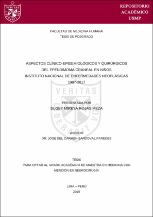| dc.contributor.advisor | Sandoval Paredes, Jose del Carmen | |
| dc.contributor.author | Rojas Meza, Sugey Mireya | |
| dc.date.accessioned | 2020-08-31T18:15:07Z | |
| dc.date.available | 2020-08-31T18:15:07Z | |
| dc.date.issued | 2019 | |
| dc.identifier.citation | Rojaz Meza, S. (2019). Aspectos clínico-epidemiológicos y quirúrgicos del ependimoma craneal en niños Instituto Nacional de Enfermedades Neoplásicas 1987-2017 [Tesis de maestría]. Lima: Universidad de San Martín de Porres, Facultad de Medicina Humana; 59 p. | es_PE |
| dc.identifier.uri | https://hdl.handle.net/20.500.12727/6456 | |
| dc.description | RESUMEN
Objetivos: Describir los aspectos clínico-epidemiológicos y quirúrgicos del ependimoma craneal en niños en el Instituto Nacional de Enfermedades Neoplásicas entre los años 1987-2017.
Metodología: Es un estudio observacional realizado entre los años 1987-2017, que considera a 53 niños operados de ependimoma craneal en el Instituto Nacional de Enfermedades Neoplásicas.
Resultados: Se identificaron 53 pacientes, el 47.2% fueron mujeres y el 52.8% de varones. En la tomografía espiral multicorte y/o en la resonancia magnética cerebral se encontró que un 58.5% tuvo localización a nivel infratentorial y en el 41.5% supratentorial. Los 31 pacientes con tumores de localización infratentorial presentaron hidrocefalia al momento de su ingreso y 26 se colocó derivación ventrículo peritoneal en el preoperatorio. Se realizó resección total de tumor en 47.2% y subtotal en 52.8%. 45 pacientes recibieron radioterapia 40 Gys a cráneo total, 35 Gys a toda la columna y un boost adicional al lecho operatorio de 15 Gys. De 1984 a 1996 todos los pacientes recibieron radioterapia y a partir de 1997 solo radioterapia local en ependimoma grado II y en la actualidad a los ependimomas grado II y III con resección parcial y ependimomas anaplásicos. Solo el 15% recibió quimioterapia. Un 3.8% presentó metástasis intraespinal.
Conclusiones: No hubo diferencias en cuanto a hombres y mujeres. En la TAC y RMN cerebral se encontró que un 58.5% del ependimomas craneal tuvo localización a nivel infratentorial y el 41.5% supratentorial. La localización infratentorial presentó hidrocefalia al momento de su ingreso y se le colocó derivación ventrículo peritoneal en el preoperatorio al 83.8%. Tuvieron resección quirúrgica total el 47.2% y subtotal en 52.8%. El 15% recibió quimioterapia por ser menor de tres años. Recurrencia craneal en el grado II en 56% y en el grado III 71.4%. El 3.8% presentó metástasis espinal. La supervivencia del ependimoma craneal en niños a los 3, 5 y 10 años es de 91%, 82% y 41% respectivamente a diferencia que el ependimoma anaplásico a los 3, 5, 10 años es de 74%,52% y 0%. | es_PE |
| dc.description.abstract | Objective: To describe the clinical-epidemiological and surgical aspects of intracranial ependymoma in children of age in the National Institute of Neoplastic Diseases between 1987-2017.
Methodology: It is an observational study that was carried out between 1987-2017, considering 53 children operated on intracranial ependymoma at the National Institute of Neoplastic Diseases.
Results: 53 patients were identified, 47.2% were women and 52.8% were male. In multislice spiral tomography and / or brain magnetic resonance imaging it was found that 58.5% had location at the infratentorial level and in 41.5% supratentorial. All 31 patients with tumor with infratentorial location presented hydrocephalus at the time of admission and all were placed peritoneal ventricular bypass in the preoperative period. Total tumor resection was performed in 47.2% and subtotal in 52.8%. They received 45 radiotherapy patients and it was 40 Gys to the total skull, 35 Gys to the entire spine and an additional boost to the operating bed of 15 Gys. From 1984 to 1996 all patients received radiotherapy and from 1997 only local radiotherapy in grade II ependymoma and currently only to anaplastic ependymomas. Only 15% received chemotherapy. 75.5% had no metastases, only 3.8% intraspinal and 20.7% is unknown.
Conclusions: Here were no differences in men and women. CT and MRI of the brain found that 58.5% of the cranial ependymomas had localization at the infratentorial level and 41.5% supratentorial. The infratentorial location presented hydrocephalus at the time of admission and a peritoneal ventricular shunt was placed in the preoperative period at 83.8%. They had total surgical resection 47.2% and subtotal in 52.8%. 15% received chemotherapy for being under three years old. Cranial recurrence in grade II in 56% and in grade III 71.4%. 3.8% presented spinal metastases. The survival of the cranial ependymoma in children at 3, 5 and 10 years is 91%, 82% and 41% respectively, unlike the anaplastic ependymoma at 3, 5, 10 years is 74%, 52% and 0%. | es_PE |
| dc.format.extent | 59 p. | es_PE |
| dc.language.iso | spa | es_PE |
| dc.publisher | Universidad de San Martín de Porres | es_PE |
| dc.rights | info:eu-repo/semantics/openAccess | es_PE |
| dc.rights.uri | https://creativecommons.org/licenses/by-nc-nd/4.0/ | es_PE |
| dc.source | Repositorio Académico USMP | es_PE |
| dc.source | Universidad San Martín de Porres - USMP | es_PE |
| dc.subject | Ependimoma | es_PE |
| dc.subject | Carcinoma | es_PE |
| dc.subject | Radioterapia | es_PE |
| dc.subject | Quimioterapia | es_PE |
| dc.title | Aspectos clínico-epidemiológicos y quirúrgicos del ependimoma craneal en niños Instituto Nacional de Enfermedades Neoplásicas 1987-2017 | es_PE |
| dc.type | info:eu-repo/semantics/masterThesis | es_PE |
| thesis.degree.name | Magíster en Medicina | es_PE |
| thesis.degree.grantor | Universidad de San Martín de Porres. Facultad de Medicina Humana. Sección de Posgrado | es_PE |
| thesis.degree.discipline | Neurocirugía | es_PE |
| dc.publisher.country | PE | es_PE |
| dc.subject.ocde | https://purl.org/pe-repo/ocde/ford#3.02.00 | es_PE |
| renati.level | https://purl.org/pe-repo/renati/level#maestro | es_PE |
| renati.type | https://purl.org/pe-repo/renati/type#tesis | es_PE |








